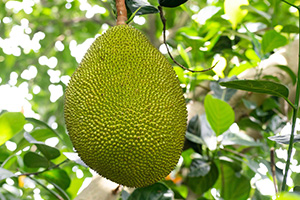 Jackfruit is the largest fruit grown on a tree. One jackfruit can weight 10-100 lbs.
Jackfruit is the largest fruit grown on a tree. One jackfruit can weight 10-100 lbs.
Background:
- Jackfruit is a member of the Moraceae botanical family which also includes figs, mulberry, and breadfruit.
- Jackfruit is native to tropical Asia and has bumpy green skin.
- The flesh of a ripe jackfruit is yellow and fibrous and tastes like a pineapple or mango.
- The flesh of an unripe jackfruit is white and has a bland taste.
- Unripe jackfruit can soak up flavors and is typically used in savory dishes such as vegan meat substitutes.
- Fresh jackfruit contains edible seeds that can be boiled or roasted.
- Fresh jackfruit has a sticky, white latex sap. If you have a latex allergy and avoid other latex cross reactive foods, ask your provider if jackfruit is safe for you.
Nutrition:
Jackfruit is an excellent source of vitamin C and vitamin B6 and a good source of potassium and magnesium.
- Vitamin C supports immune function, wound healing, and collagen and connective tissue formation.
- Vitamin B6 is involved in immune and nervous system function as well as red blood cell formation.
- Potassium supports fluid balance, heart function, and muscle contraction.
- Magnesium helps regulate blood sugar and blood pressure regulation, bone formation, and hormone secretion.
How to purchase, prepare and store:
- Purchase fresh jackfruit at Asian grocers or health food stores.
- Ripe jackfruit has a stronger smell than unripe jackfruit and gives a little when the skin is gently pushed. Unripe jackfruit will ripen on the countertop. Avoid jackfruit with dark spots.
- Jackfruit can also be purchased canned, dried, or frozen. Canned jackfruit is packed in water, brine, or syrup.
- If purchasing jackfruit as a meat substitute, look for labels that say green, young, or tender.
- To prepare fresh jackfruit, place a sheet of plastic wrap on your table. To avoid the sticky sap, wear food safe gloves and wipe your knife with oil to avoid it from getting sticky with sap. Use caution with the knife as it will be slippery and you do not want it to slip while cutting.
- Cut the jackfruit into quarters and remove the white core trailing down each quarter as it is inedible.
- Remove the seeds from the flesh and set aside. These can be roasted and seasoned later for a healthy snack.
- Next, remove the fruit pods by bending each quarter of the jackfruit so the fruit separates from the fibrous flesh.
- Lastly, remove any fibrous pulp from the fruit pods and prepare as recommended by your recipe. The ripe fruit pods can be rinsed with cold water and eaten as is.
- Ripe jackfruit can be eaten fresh, mixed into yogurt or ice cream, or added to a salsa, salad, or smoothie.
- Unripe jackfruit can be added to soups, stir fries, or cooked as a meat substitute.
- The jackfruit seeds can be boiled or roasted and seasoned for a fun snack. Seeds should only be eaten once cooked.
- Jackfruit can be pan fried, baked, roasted, or slow cooked.
- Store jackfruit in the refrigerator for up to one week or in the freezer for up to one month.
Nutrition Facts
(1 cup jackfruit pieces, raw)
- Calories: 143
- Protein: 2.6 g
- Fat: 0.966 g
- Carbohydrate: 35 g
- Fiber: 2.26 g
- Calcium: 36.2 mg
- Iron: 0.347 mg
- Magnesium: 43.8 mg
- Phosphorus: 31.7 mg
- Folate: 36.2 µg
- Vitamin A: 7.55 µg
Via fdc.nal.usda.gov
Recipes
Request an Appointment